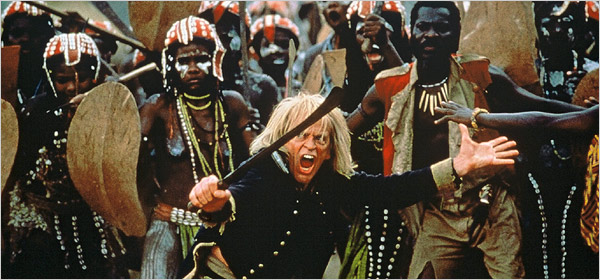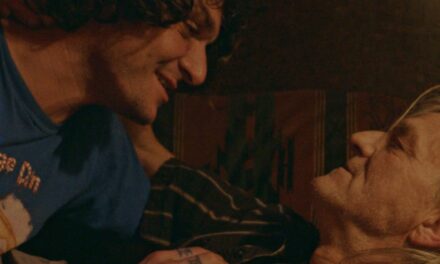
The lost Werner Herzog/Klaus Kinski film gets its theatrical release. . .20 years later. This time Klaus plays a notorious Brazilian bandit called “Cobra Verde” whose stare-down of a rebellious slave impresses a local sugar baron. He finds himself the slave overseer on a massive plantation, until he knocks up the boss’ daughter(s). The powers that be realize that anyone who tries to discipline or exact revenge on Kinski will wind up dead — so they come up with a brilliant idea. Shipments of slaves have dried up in the last few years. The British have outlawed the trade, the Arabs have the East Coast of Africa all tied up and their old contact, the King of Dahomey, has gone completely batshit. Any white man who goes over there will surely be killed. Why not send Cobra Verde? He’ll probably be killed, and what’s the worse case scenario if he doesn’t? More slaves! It’s win-win!
So we’re off to Africa, and if this were a Hollywood film here’s where Cobra would find redemption. He’d recognize the nobility of the indigineous African and learn a lot about himself. And while there are trace elements of this arc in Herzog’s film, it’s never as easy as you expect.
For one thing — everyone in this movie is evil. More so than “The Sopranos,” there is not one character with a shred of humanity. What I found most impressive was the stark and matter-of-fact treatment of slavery. When Kinski gets his castle up and running, the images of suffereing are not lingered over Amistad-style. . .they are just there. Men are poked for the muscles, girls oogled for their rapeability. And the place is just ugly. Movies often still retain a Kipling-esque eye for the noble look of imperialism. None of that here. Kinski sleeps in a torn hammock in a hot room full of peeled paint and skittering hermit crabs. The movie smells.
By act three we really fly out into the unknown. Political machinations amongst the tribesmen lead to a radical setpiece of Kinski training hundreds of fierce topless women in mortal combat. We are then treated to a string of (how else to describe it?) Herzog-esque sequences, each topping the other in their strange beauty and haunting peculiarity.
I have nothing negative to say about “Cobra Verde,” yet there is something holding me back from giving this a full-on A. Maybe it is the unlikeability of the central character. He does make a passing reference to the criminality of slavery, but his actions are all opt-in. I’ll have to think about this and get back to you.








